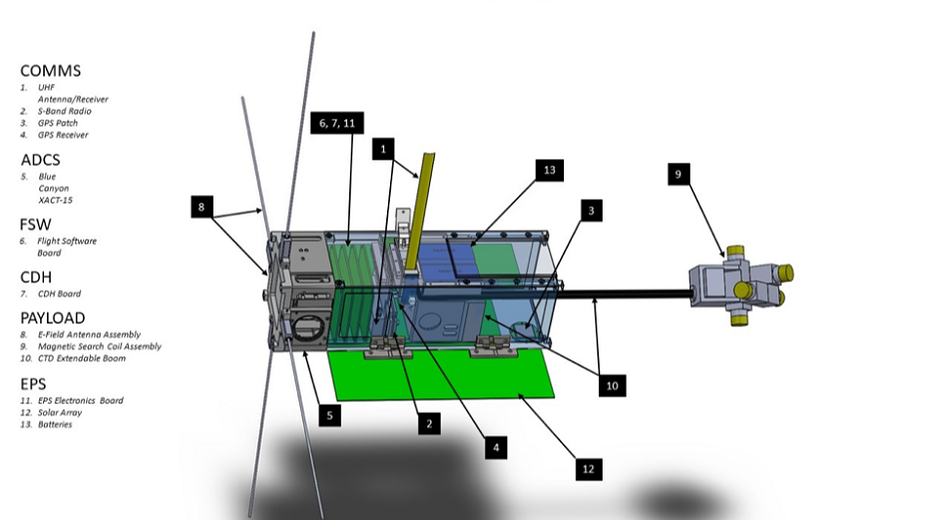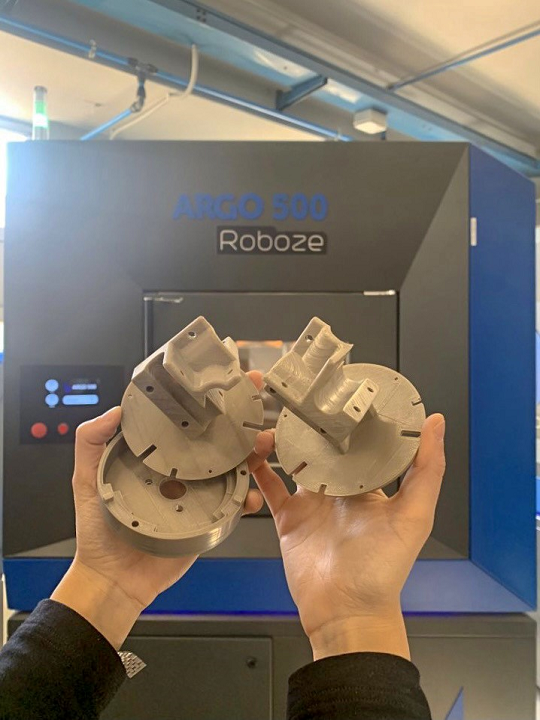A CubeSat is basically just a miniature satellite, and 3D printing technology has been used to create these outer space devices multiple times in the past. This week, Italy-headquartered industrial 3D printer manufacturer Roboze announced that a team of researchers from the University of Colorado Boulder had selected its technology to optimize the design of, and 3D print, the components for a CubeSat project called CANVAS, or Climatology of Anthropogenic and Natural VLF wave Activity in Space.
The project, which is based out of the university’s department of Aerospace Engineering Sciences, is focused on measuring the electromagnetic waves that occur when lightning discharges on the surface of the Earth. According to CANVAS, this occurs “globally 50 times a second!”
“The electromagnetic energy that occurs from a lightning flash (also called an electromagnetic pulse, or EMP) is mostly in the very low frequency (VLF) range and propagates throughout the Earth-ionosphere waveguide,” the CANVAS website states. “When the lightning EMP enters the magnetosphere, it propagates as a whistler-mode wave, often simply referred to as a “whistler”, named from the short descending tone heard when played back over audio. These whistlers can then interact with radiation belt particles and play a role in radiation belt dynamics, even inducing electron precipitation events [Graf et al., 2009]. In addition to lightning, ground-based transmitters can also radiate VLF energy into the magnetosphere and interact with the radiation belts. VLF wave propagation can also reveal characteristics of the D-region of the ionosphere, the lowest level of the ionosphere.”
In 2019, the CANVAS project received funding from the NSF to begin the work of measuring VLF waves in low Earth orbit (LEO). After the first validation phases are complete, the CubeSat, with its 3D printed components, will be launched into space in early 2022, where it will spend at least six months measuring the electromagnetic effects of space storms.
The university’s Lightning, Atmosphere, Ionosphere and Radiation Belt (LAIR) research team chose to use 3D printing, rather than more traditional methods of manufacturing, to make critical components for its CANVAS CubeSat due to the device’s complex geometries, such as volume limitations and strict mass requirement, and small size. It’s a 3U CubeSat, which means that it has to fit the power system, instruments, radio, attitude determination and control system, and onboard computer and data storage, into a space that measures only 30 x 10 cm.
“Because we are so constrained by mass, 3D printing was the ideal solution for our CubeSat. Roboze allowed us to meet the requirements of the project by guiding us in choosing the most suitable material and in the optimization of the parts to minimize mass. We are very satisfied with the results we are achieving,” explained Vicki Knoer, one of the CANVAS project researchers.
Roboze’s industrial 3D printers are often used for extreme end-use applications, and the LAIR researchers working on the CANVAS project decided to use the company’s Argo 500 system, and high-performance polyetheretherketone (PEEK) material, to 3D print the magnetic field sensor holders for its CubeSat.
“Thanks to extraordinary mechanical properties as well as high thermal and chemical resistance, 3D printing is rapidly replacing metal in a wide variety of extreme end-use applications including aerospace, mobility and energy. It was an honor and a real privilege to collaborate with the LAIR group on this project. They are one of the pioneers in the use of additive technology in this field and giving our support to the realization of their mission makes me extremely proud,” said Roboze CEO and Founder Alessio Lorusso.
(Source: Roboze)
Subscribe to Our Email Newsletter
Stay up-to-date on all the latest news from the 3D printing industry and receive information and offers from third party vendors.
You May Also Like
Rickie Fowler Spotted with Cobra’s New 3D Printed Lob Wedge at American Express Tournament
Cobra has been at the forefront of 3D printed golf equipment since 2018. Now, its newest 3D printed golf club, a 60 degree lob wedge, was recently spotted in Rickie...
Snarr3D Introduces the First 3D Printed Golf Club Shaft
What started out as a class project could soon help golfers save a few strokes per round. Brothers and business partners, Patrick and Scott Snarr, have created Snarr3D, a golf...
GE Additive and Callaway’s 3D Printed Putter Heralds Sea Change in Sporting Goods
As golf giants Cobra and PING explore new ways to incorporate additive manufacturing (AM) into their production lines, it’s worth acknowledging that Callaway has been exploring the technology since at...
Review: Cobra 3D Printed Putter Improves 3DPrint.com CEO’s Golf Game
In our latest product review, Alan Meckler, CEO of 3DPrint.com’s parent company, 3DR Holdings, had the opportunity to test out one of Cobra Golf’s 3D printed putters, made using HP’s...


































